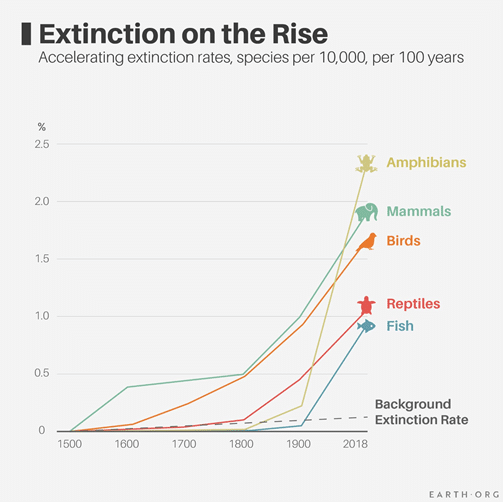
Why this Metric
Humans have taken over the world, and some say we’ve entered the Anthropocene or the era of man. Half the world’s habitable land is now used for agriculture, doing away with the forests, grasslands, shrubbery and other natural habitats that used to be.
The IUCN Red List keeps track of known species populations and has estimated the number of extinctions since 1500. They estimate that about 900 species have disappeared for good and that 35,765 species are threatened with extinction today. Another study led by Gerardo Ceballos claims that extinction rates are 100 to 1000 times higher today than the baseline extinction rate (around 1 species per million per year).
Exploring the Metric
To understand the importance of this topic, we need to understand what would happen if biodiversity truly collapsed. Rich ecosystems depend on their biodiversity, and we depend on the ecosystems. The services they provide are priceless, though if we were to put a price on them, it would be US$16-54 trillion according to Robert Costanza.
As for the extinction rate itself, there are a few caveats. Our knowledge of the natural world is far more limited than one might think: we’ve identified an estimated 80% of animals such as birds, mammals and amphibians, but only 1% of insects, and less than 1% of the world’s fungi. Further, the IUCN Red List has assessed only 6% of described species. These two facts together mean that the number of identified threatened species is likely far lower than the actual number.
Conversely, Ceballos’ findings compare the base extinction rate (2 species per 10,000 per 100 years (E/MSY)) to the amount of recorded extinctions since 1500. He found that these were 100 times higher than the baseline rate. Considering there were probably far more extinctions than those recorded, the estimate is very conservative.
Future Outlook
Many have claimed that we are at the dawn of the 6th mass extinction. First, let us remind you that mass extinctions in the past wiped out 75% to 95% of all species, usually over the course of thousands of years.
This makes it perfectly plausible that we are witnessing the start of a new, human-induced extinction episode. Whether or not this is the case, time will tell, but one thing is clear. Were ecosystems to collapse, no amount of bailouts would make up for the lost services they’d have provided. This problem enters the realm of serious existential crises that humanity will face a number of over the next few centuries.
Editor’s note: We left out the “Where the numbers come from” section you’re used to because methods are a core part of the discussion. If you wish to do some further reading, the IUCN’s methods are available here.
This article was written by Owen Mulhern.
You might also like: EO Indexes: Longer Summers.










![The Statistics of Biodiversity Loss [2020 WWF Report]](https://u4d2z7k9.rocketcdn.me/wp-content/uploads/2020/12/lprwinkyTHB-544x306.jpg)





